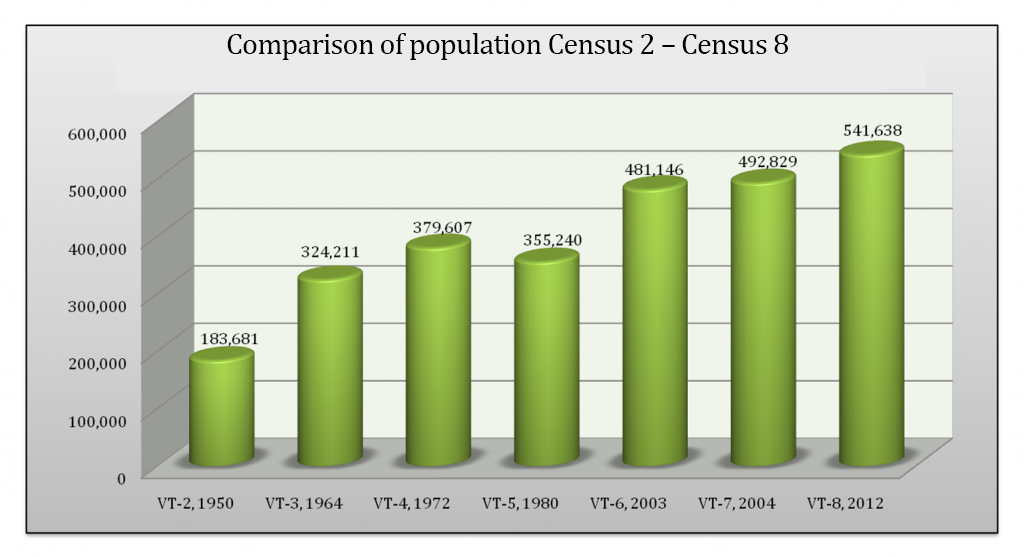The most important data sources for the General Bureau of Statistics are total counts, the most famous is the Population and Housing Census, or census for short.
The United Nations (UN) definition of a census is (freely translated):
The entire process of collecting, processing, evaluating, analyzing and publishing (or otherwise disseminating) demographic, social and economic data of all persons in a country or of a well-defined part of a country, at a specific time.
A census has the following characteristics:
1. Individual counting: Each household and each person is counted separately. A separate questionnaire is used for the counting of each household. Questions are asked about each person who is a member of that household and the answers are noted per person.
2. Universality within a defined area. The area to be counted must be well defined (the boundaries must be well known). The Census may not exclude persons or households from counting if they are eligible. The Census may not count individuals or households eligible for it more than once (no double counting).
3. Simultaneous counting. Every person and every household is counted on the basis of the same counting time. For example: at the Eighth General Population and Housing Census, which was held in Suriname in 2012, the counting time was 13 August, midnight. Every person who at that time belonged to the population, who usually reside in Suriname, was eligible for counting.
4. Periodic counting. A Census should take place on a regular basis, at least every 10 years. This makes it possible to make estimates about future developments in a country. This is necessary for planning and policy based on data (evidence based).
As noted earlier, there are different total counts or Censuses.
- The Population and Housing Census
- The Agricultural Census
- The Enterprises Census
In Suriname, the Agricultural Census is carried out by the Ministry of Agriculture, Livestock and Fisheries, with support from the ABS.
The ABS is responsible for the implementation of the Population and Housing Census and the Enterprise Census.
We speak of a General Population and Housing Census, because we count throughout the country. No parts of Suriname are excluded from counting. Instead of a “General Population and Housing Census”, we also speak of a “Population count” or a “Census”. Because of the aforementioned characteristics, a Census is a large and complex operation. The United Nations characterizes a census as the greatest movement of people and equipment in peacetime in a country.
Organizing a census requires:
- Mapping the entire country (listing).
- Mobilizing and training a large group of field workers.
- Setting up a large publicity campaign to get full cooperation from households and individuals.
- A large group of field workers visiting all households.
- Collecting individual information.
- Collecting large quantities of completed questionnaires and other fieldwork material at the end of the census.
- Processing, analyzing and distributing the aggregated census data.
Why is a census carried out?
A census is carried out to gain regular insight into the quantity and quality of a country’s important natural resource, namely human capital. It is important for the specific planning of a country’s development to know this information at national, but also at sub-national level (per district, per ressort).
Apart from the question: “How many people are in Suriname?” It is necessary to answer other questions such as:
Who are we (in terms of age, gender, education, profession etc.)? Where and how do we live (in terms of housing, availability of water, access to essential facilities, access to modern communication options, etc.)?
For many countries, a census is the only opportunity to collect such information throughout the country and at the lowest level, because the country is being combed and because information is collected about every individual and every household in that country in a short, defined period. For small geographical areas or subpopulations, the census is a source of information about certain social, demographic and economic characteristics that cannot be collected on another occasion.
In addition, the census offers the possibility of developing sample frameworks, for the purpose of surveys conducted between two consecutive censuses.
Confidentiality of data
The success of a census requires that the inhabitants of the country fully cooperate. Guaranteeing the confidentiality of the information provided by individuals and households is crucial. The only reason why the General Bureau of Statistics / Census Office collects individual data is for the production of statistics on the population and on households.
The ABS is functioning according to the Fundamental Principles of Official Statistics (link Fundamental Principles of Official Statistics )of which principle 6 states:
“Individual data collected by statistical agencies for statistical compilation, whether they refer to natural or legal persons, are to be strictly confidential and used exclusively for statistical purposes.”
Individual information will not be disclosed or distributed in any way by the ABS. The information will not be used for purposes other than statistical.
Population and housing censuses were held in Suriname in the following years: 1921, 1950, 1964, 1972, 1980, 2003, 2004 and 2012.

The Eighth Population and Housing Census
The Eighth Census had 13 August 2012 as census day. The field work of Census eight was successfully completed and the first preliminary results were published in January 2013.
In September 2013 the first definitive results of the Eighth General Population and Housing Census were published, in a publication “Results Eighth General Population and Housing Census in Suriname Volume I, Demographic and Social Characteristics and Migration”. This publication contains tables about the size, composition and migration flow of the population.
Up to and including February 2014, the ABS produced a total of 5 publications with national results on the themes: Employment and Education Characteristics, Fertility and Mortality, Health and Sport, Households, Families and Housing, Environment and Crime.
Subsequently, in the period March to May 2014, the ABS also produced 3 publications, in which the same tables can be found as in the national publications, but for all 10 districts separately.
Finally, the ABS published the 2 last Census publications, namely Population Projections in July 2014 and the Technical Evaluation of the 8th Census in August 2014.

